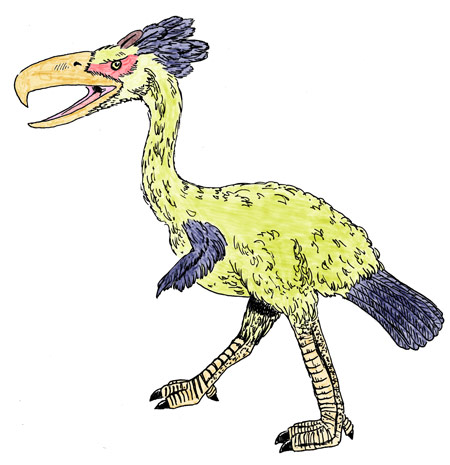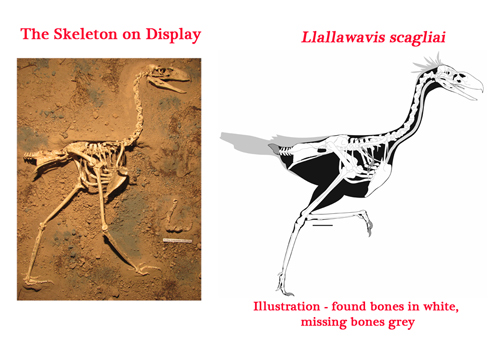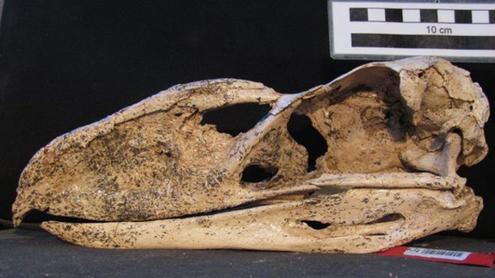The Sensory Capabilities of Terror Birds
New Study Suggests Phorusrhacids had Deep Voices
A ninety percent complete fossil specimen of a Terror Bird (phorusrhacid) excavated from cliffs south of the Argentinean city of Mar del Plata (Buenos Aires Province), has provided palaeontologists with new information regarding the sensory capabilities of these predators.
The superbly preserved skull permitted the researchers to re-construct this flightless bird’s inner ear and the team were able to deduce that this particular phorusrhacid had a greater sensitivity to low frequency sounds than many modern Aves. From this, it is has been suggested that these large birds vocalised by producing low frequency sounds.
The Phorusrhacidae
The Phorusrhacidae are an extinct family of birds that belong to the Order Cariamiformes. The ancestors of these large, flightless birds probably evolved sometime in the Late Cretaceous and it was after the demise of the dinosaurs that many new forms evolved, taking over the role of apex predators on the isolated continent of South America. Typically, phorusrhacids had long, powerful legs, a narrow pelvis, very reduced, stubby wings and large skulls, endowed with a long, strong hooked bill.
A Typical South American “Terror Bird” (Kelenken guillermoi)
Picture credit: Everything Dinosaur
Kelenken
The picture shows a colourful interpretation of Kelenken, a large phorusrhacid of the Middle Miocene of South America. This new “Terror Bird” has been classified as a member of the sub-family of the Phorusrhacidae, the Mesembriornithinae and the fossil material excavated from sandstone which forms part of the cliffs at La Estafeta Beach, to the south of the popular tourist destination of Mar del Plata, has been dated to older than 3.3 million years (Middle Pliocene).
Llallawavis scagliai
The bird has been named Llallawavis scagliai. The genus is from the Latin for bird “Avis” and the word Llallawa from the local Quechua language for “magnificent”, in reference to the amazing fossil preservation and the nearly complete skeleton found. The species name honours Galileo Juan Scaglia (1915–1989), naturalist, director and one of the founders of the nearby Museo Municipal de Ciencias Naturales Lorenzo Scaglia, where the specimen is on display. Grandson Fernando Scaglia, now himself a highly regarded member of the Museum’s staff, was one of the authors of the scientific paper that has just been published in the Journal of Vertebrate Palaeontology.
The Skeleton on Display and an Illustration of Llallawavis scagliai
Picture credit: Skeleton courtesy of M. Taglioretti and F. Scaglia/Illustration Degrange et al
The wonderful skeleton allows the scientists to learn more about these birds anatomy and as it is very nearly complete, it permits researchers to learn more about how different types of “Terror Bird” were related to each other.
Carnivorous Bird
Standing at about 1.2 metres tall and weighing about 18 kilogrammes, L. scagliai was about as big as today’s largest South American bird, the Greater Rhea (Rhea americana). Dr Degrange, one of the research paper’s authors commented that this bird probably ate small mammals, other birds and lizards. The exquisite skull gave the researchers the opportunity to take some precise CAT scans and to reconstruct the inner ear. Based on subsequent measurements and comparative studies of both extinct and extant Aves, the team concluded that this bird was capable of rapid head movements, a behaviour indicating that this predator, did indeed, hunt small prey.
In addition, with a preserved trachea and a map of the inner ear, the scientists could postulate about vocalisation and the sort of sounds that Llallawavis could hear. The researchers state that their estimations of hearing sensitivity in Cariamiformes, places Llallawavis below the average for a living species. As the vocalisation range of most birds falls within the lower half of their hearing sensitivity range, Llallawavis scagliai may have produced low frequency sounds.
Dr Degrange explained:
“Based on our comparisons with living species, these measurements suggested that the ears of terror birds like Llallawavis were most sensitive to low-pitched sounds. We are able to say that Terror Birds had low frequency sensitivity – so it seems reasonable to suggest that they also produced low-frequency sounds.”
The Beautifully Preserved Skull of Llallawavis scagliai
Picture credit: Degrange et al
“Terror Birds”
Not all the so-called “Terror Birds” were predators. Back in 2013, Everything Dinosaur reported on some new research on Gastornis (also referred to as Diatryma), which suggested that this early “Terror Bird” was a vegetarian. Contrary to popular belief, Gastornis was not closely related to the phorusrhacids.
Read more about this study: Isotope Study Suggests “Terror Bird” Gastornis was a Herbivore.
The CollectA Deluxe Prehistoric World range of models contains a replica of a “Terror Bird” – Kelenken. To view this range of replicas: CollectA Deluxe Prehistoric World Figures.




